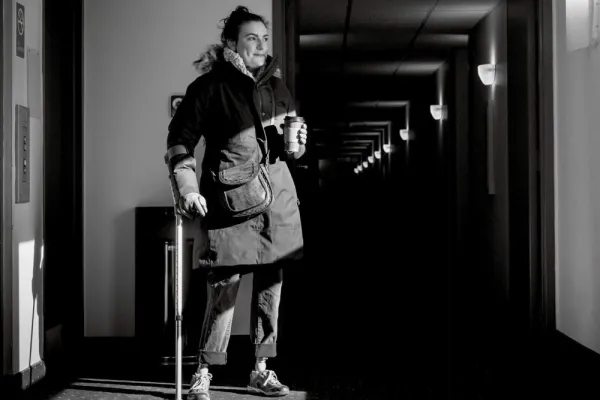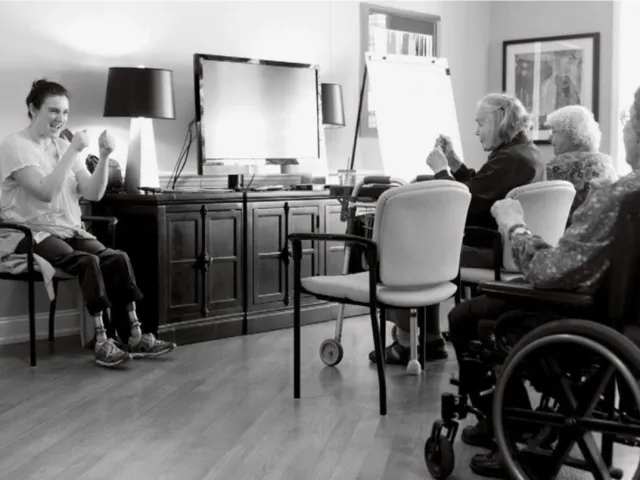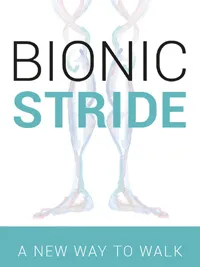Walking Tall
Alum News

Published March 9, 2018
At the assisted-living center where she’s the activities director, Clara Gardner ’16 is leading a seated-exercise class, her students imitating her movements. “Great job, everyone!” she calls out cheerfully.
Instead of demonstrating the next exercise, though, she instructs students to lift their feet and circle them. When one woman is confused, Gardner explains with characteristic frankness, “So, I can’t do it because I have a fake leg.”
That Gardner is orchestrating an exercise class is testament to her fierce commitment to leading an active, engaged life. Such an outcome was anything but assured in 2008, when a drunken driver shattered her world. That evening, Gardner, who was 16, had just returned from an intensive language program in Mexico. At the train station, as she was loading her luggage into the trunk, a car slammed into her, pinning her legs between the two vehicles. She doesn’t remember much about that night, but when she came to, both her legs had been amputated above the knee. Only later did she learn that, to save her life, doctors had to give up trying to save her limbs. Her mother, Kate O’Kane, remembers her daughter waking up and saying, “Mom, my life is going to be really different, isn’t it?” To this, O’Kane replied, “Yeah, honey, it’s going to be different, but it’ll be OK. We’ll make it OK.”
Two months, several surgeries and many hours of grueling rehab later, she was back at Northampton High School to complete her senior year. She’d considered taking a year off before college, but ultimately she and her family felt the stability of college life, specifically at a college near her health-care team, was the best option for moving forward. A year after losing her legs, Gardner entered Smith as a member of the class of 2013.
For two years, Gardner remained committed to completing her degree on time. She loved living in Haven House and partaking in all the rich traditions of campus life, like the raucous convocation in which she and other Haven women donned bras and jeans to march to John M. Greene Hall. But after a time, the challenges of college overwhelmed her. She had prosthetic legs, but she spent virtually all of her time in her wheelchair. “Walking as a bilateral amputee is really, really hard,” she says. And she had to keep up with her academics, even as she struggled with insomnia from the pain of her amputations. “Once I was at Smith awhile, I realized I wasn’t going to be able to get up and walking while there because it was too much,” she says. “Smith is a demanding place. I wasn’t able to split my focus any longer.” By the end of her second year, she was in, as one friend describes it, “a dark place with her wheelchair.” In retrospect, Gardner sees that she’d been depressed. “I think I was in denial most of that time and not dealing with my emotions,” she says. “That’s one of the stages of grief—denial—and I kept that part going for a long time.”

Gardner’s enthusiasm brightens the exercise class she leads at an assisted-living center.
Gardner decided to take a leave from Smith so she could devote herself to gaining proficiency with her prosthetics. “I was like, ‘I’m not coming back to Smith till I get up and walking,’” she remembers. Around that time she began meeting war veterans who were amputees. She attended a prosthetics boot camp, and she embraced something she had avoided before: spending time with other amputees who could help her come to terms with what life had dealt her. She took advantage of improvements in prosthetic technology that were making it easier to walk, though it still took a lot of time, effort and singular focus.
Gardner began taking classes at Smith again, although numerous medical appointments and the intensity of her disability slowed her progress. When she finished in January 2016, she planned to walk at her Commencement the following May. But life handed her another twist: She had learned of a new surgical procedure that promised to reduce her pain and drastically reduce the amount of time she spent in a wheelchair. The only hitch was she would have to go to Australia to have it done.
The procedure is called osseointegration, a prosthetic technology used in Europe since 1990, but not yet FDA-approved. The computerized socket system prosthetic that Gardner had been using since 2012, though better than her first prosthetic legs, caused chafing and severe pain. With osseointegration, she learned at a lecture given by a doctor experienced in the surgery, a titanium rod is implanted into the femur. The bone then grows around the rod, actually becoming thicker as it bears the person’s weight, according to Dr. Munjed Al Muderis, who says he has performed the procedure about 500 times at his practice in Sydney. The rod fits into an attachment and in turn into a prosthetic, offering better alignment with the spine. In essence, the rod becomes an extension of the femur. The new system would make Gardner’s gait more natural and hopefully result in less pain and less time in her chair. “I was trying not to get too excited about it, because I didn’t know all the facts,” Gardner recalls, “but the idea of walking without sockets was so exciting.”
The cost, however, was prohibitive for a 6.5-hour operation that would not be covered by insurance. Plus, there was travel to and from Australia, and six weeks there working with a team of physical therapists twice daily after surgery. All told, the cost was close to $100,000. Gardner and her family launched an online fundraising effort that drew donations from the Northampton community and from many Smith alumnae, raising $63,000, including $10,000 from an anonymous donor.
In Sydney, Gardner spent a few days before the operation undergoing tests and talking to Al Muderis. “He was very upfront about the risks,” said Gardner. “It’s a very painful surgery.” The operation involved drilling into the femur, inserting the rod and then reattaching the leg muscles with great care so as to promote muscle growth around the rod. “This technology,” Al Muderis explains, “allows patients to regain their biomechanical alignment … and bring them as close to normality as possible.”
Osseointegration is not without controversy. Some people object to the gruesome nature of drilling a rod into the thighbone. And although risks have lessened in the 20-plus years it’s been performed, the potential remains for serious infection. Further, some fear that amputees will break a femur bone if they fall.
For Gardner, both surgery and recovery were a success. Walking is easier, she says, and she can feel her femur bones getting stronger and stronger. Nevertheless, every day she endures pain. “I’m still an amputee, so there are going to be challenges other people don’t have to deal with, but this is such a huge improvement,” she says.
In the decade since the accident, Kate O’Kane says she has been impressed by how her daughter approaches whatever comes her way. “There would be a tendency to get depressed and crumple up, but she has really pushed through,” O’Kane says. “She has really been striving to have a normal life.”
Today, Gardner lives in Northampton with her boyfriend, Jeffrey Rogers, whom she met online in 2013. While at home, she often scoots around their apartment, low to the ground on her fanny and hands, and she occasionally uses her chair. Out in the community, though, she prefers to use her prosthetic legs. Rogers, 29, a student at the University of Massachusetts, is an Army veteran who was a front-line medic in Afghanistan. There, he saw his share of injuries, some of which led to amputations. When Gardner created her online dating profile, she didn’t want to mention that she’s an amputee; but she didn’t want to hide it, either. So among the photographs she included was one in which her prosthetics were visible. Rogers noticed the photo, but waited for Gardner to bring it up. “I figured if she wanted to talk about it, she would talk about it,” he says. The topic arose on their first date. “You just said straight up what happened to your legs,” Rogers recalls. “I didn’t even have to ask.”
On a blustery November evening, Gardner and Rogers are sitting together in their living room on a white couch, candles burning nearby, talking about their “normal life.” For both, this is their longest relationship. “I don’t know how we get along so well, I really don’t. I’m shocked,” Gardner says, prompting laughter from both.
And they’re looking ahead. In mid-December, they moved into a downtown Northampton apartment with better accessibility and no stairs. “I love being able to walk everywhere,” Gardner says. Rogers, who is a hospital orderly, is aiming to become an occupational therapist. Gardner is considering graduate school in social work, possibly pursuing a specialty in geriatrics.
She has been surprised to learn, while working at the assisted-living center, that she enjoys working with elderly people. “I thought I wanted to work with kids. What’s made me like the elderly,” she says, “is they have this life experience; they’re adults, and they want to be treated like adults. I think it’s an under-nurtured community.”
She realizes that her motivation might also stem from a sense of kinship. “They’ve figured out how to deal with living in pain,” she says. “A lot of their emotional pain is from losing their independence, which I understand very well. Wanting your independence: I can relate to that.”
Laurie Loisel is a freelance writer in Northampton.
This story appears in the Spring 2018 issue of the Smith Alumnae Quarterly.
Smith ID
House: Haven
Major: Spanish
Favorite Smith Professor: “Ibtissam Bouachrine, associate professor of Spanish and Portuguese. “She always chose interesting stuff for us to read, and in the projects we were able to be really creative. We’d have papers, but for a final, I did an art project for her class. It’s an outside-the-box teaching style, which I liked. And she’s the sweetest ever.”
‘How Strong You Can Be’

Documentary filmmaker Augusta Rose witnessed how her longtime friend Clara Gardner ’16 dealt with the aftermath of losing her legs in 2008 in a tragic car accident. And Rose rooted for her as Gardner learned to navigate her life as a double amputee. As a filmmaker, Rose saw a subject with a lot of heart.
In May 2016, when Gardner and her mother, Kate O’Kane, traveled to Sydney, Australia, to undergo osseointegration surgery, Rose and creative partner Joe Aidonidis joined them. Their film, Bionic Stride: A New Way of Walking, documents the process, from preparation to surgery and recovery. “Clara has such a powerful story that it needed to be documented, not only for her, but also for the people who donated and were supporting her,” Rose says. “It’s a human interest story of resilience, and that is a universally applicable concept.”
The two women have known each other since middle school and have been in each other’s lives ever since. Rose had previously created a photo series documenting how Gardner learned to use her socket prosthetics. Their friendship adds a level of authenticity. In one scene, Rose sits with a groggy Gardner after surgery, the two holding hands; in another, the two friends are on a bed together as Gardner talks about her pain. “To quote Clara, ‘You don’t know how strong you can be until you are forced to be,’” Rose says.
Photographs by Sam Masinter